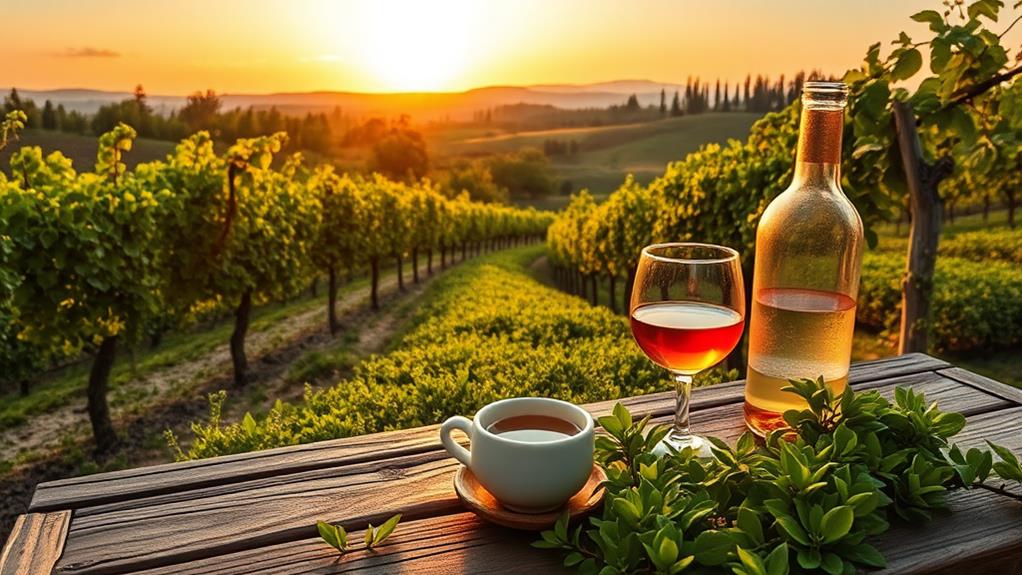When you explore tea and wine, you'll find that terroir plays a huge role in shaping their flavors. Terroir includes factors like climate, soil type, and local history. For tea, the soil's nutrients and drainage can affect its taste, while climate influences how leaves develop their unique flavors. In wine, soil composition can add earthy notes, while cooler climates give grapes a delicate sweetness. Different altitudes also affect flavor profiles, with higher elevations producing bolder tastes. Understanding these elements helps you appreciate the connection between what's in your glass and the land it comes from. There's so much more to uncover!
Understanding Terroir
Terroir is a fascinating concept that shapes the flavors and qualities of tea and wine. When you think about terroir, you're diving into the unique combination of factors like climate, geography, and history that influence how these beverages taste.
The terroir definitions can vary, but at its core, it reflects the idea that the land where tea and grapes grow plays a crucial role in their characteristics. Tea, for instance, is deeply influenced by its environment, as seen in the diversity in tea types that reflect regional flavors and practices.
Historically, terroir has held significant importance in the world of agriculture and gastronomy. For centuries, different regions have cultivated distinct plants, leading to unique flavors that tell a story about their environment.
Imagine sipping a cup of tea that carries hints of the misty mountains or savoring a wine that embodies the warm sun of a particular vineyard. Each sip brings you closer to the land, connecting you to its past.
The Role of Soil
The influence of soil on the flavors of tea and wine can't be overstated. The unique characteristics of soil can drastically affect how plants absorb nutrients and water, ultimately shaping the taste of your favorite beverages. Understanding these aspects can spark innovation in cultivation techniques.
| Soil Component | Importance | Ideal Characteristics |
|---|---|---|
| Soil Fertility | Supports plant growth | High nutrient balance |
| Organic Matter | Enhances microbial activity | Rich in compost and nutrients |
| Drainage Capacity | Prevents waterlogging | Well-draining soil texture |
When you're considering soil, think about its pH levels and mineral content. The right pH can optimize nutrient absorption, while a balanced mineral content boosts plant health. Water retention is also crucial, as it affects how well your tea or wine plants thrive. Plus, erosion control is essential for maintaining that rich topsoil.
Incorporating organic matter enhances microbial activity, fostering a vibrant ecosystem that benefits your plants. By focusing on these soil features, you can unlock the potential for innovative and flavorful teas and wines.
Climate's Influence
Climate shapes the flavors of tea and wine just as much as soil does. You mightn't realize it, but climate variability plays a crucial role in how these beverages develop their unique tastes. Seasonal changes can bring about different flavor profiles, while temperature extremes can stress the plants, leading to more concentrated flavors.
For instance, the rich antioxidants found in green tea are influenced by the climate in which it's grown, affecting its overall health benefits and flavor profile health benefits of green tea. Think about how precipitation patterns affect growth; too much or too little rain can completely alter the character of the leaves or grapes.
Microclimates, or small areas with distinct climate conditions, can also create unique flavors. For instance, a vineyard on a sunny slope may produce sweeter grapes than one in a cooler valley.
That's where climate adaptation comes in; growers often use innovative techniques to cope with changing conditions. They might plant drought-resistant varieties or adjust their irrigation methods to ensure climate resilience.
Understanding regional climates helps you appreciate the complexity behind each sip. Whether you're enjoying a bold red wine or a delicate green tea, remember that the climate has played a significant role in shaping those flavors.
Altitude and Elevation
Altitude and elevation play a pivotal role in the cultivation of tea and wine, influencing everything from flavor to aroma. As you explore mountain ranges, you'll notice that different elevation zones create unique environments. High altitude can lead to intense flavors, while low altitude often yields smoother, milder profiles. The terrain diversity and elevation gradients significantly affect how plants grow, resulting in distinct tastes that reflect their origins.
Here's a look at how altitude impacts tea and wine:
| Altitude Type | Flavor Profile | Growing Conditions |
|---|---|---|
| High Altitude | Bold, complex flavors | Cooler temperatures, longer days |
| Low Altitude | Milder, sweeter profiles | Warmer temperatures, shorter days |
| Mid-Altitude | Balanced, versatile tastes | Mixed conditions, diverse terrain |
| Summit Conditions | Unique, rare flavors | Harsh weather, limited growth |
| Elevation Gradients | Varied impacts on aroma | Gradual changes in climate |
Understanding these altitude effects helps you appreciate the choices behind your favorite cup of tea or glass of wine. So, next time you sip, think about the journey from the mountains to your palate!
Cultivation Practices
When you think about how tea and wine grow, it's important to realize that cultivation practices play a huge role.
The soil composition affects how plants absorb nutrients, while the climate can speed up or slow down their growth.
Plus, using sustainable farming techniques not only helps the environment but also enhances the quality of what you enjoy in your cup or glass!
Soil Composition Impact
Understanding soil composition is crucial for successful cultivation practices in both tea and wine production. The types of soil you choose can dramatically affect your crop. For instance, sandy soils have excellent drainage capacity, while clay soils retain moisture but may suffer from compaction effects.
You'll also want to pay attention to the mineral content and organic matter within your soil, as these elements directly influence fertility levels.
Soil pH is another key factor; it determines nutrient availability, and most tea and grape plants thrive in slightly acidic conditions. A balanced pH promotes healthy microbial activity, which breaks down organic material and helps nourish your crops.
When you innovate your cultivation practices, consider testing your soil regularly. This gives you valuable insight into how to adjust your practices for optimal growth.
By understanding these components, you can create the perfect environment for your tea leaves and grapevines to flourish. So, whether you're sipping a cup of tea or a glass of wine, remember that the journey starts beneath the surface, where soil composition plays a vital role in flavor and quality.
Embrace the science behind it, and watch your crops thrive!
Climate Influences Growth
Soil composition sets the stage, but climate plays a starring role in how tea and grapevines thrive. The right climate is essential for maximizing flavor and quality.
You'll find that microclimate variations, those small pockets of unique weather, can significantly influence growth.
Let's break it down into three key aspects:
- Temperature: Ideal temperatures allow tea leaves to develop their full flavor profile, while grapes need warmth to ripen perfectly. Too hot or too cold can hinder growth.
- Humidity: A certain level of humidity is crucial. For tea, it helps retain moisture, while grapes need it just right to prevent disease.
- Seasonal Changes: Different seasons bring different challenges. Spring can spark growth, while autumn is vital for harvest. Understanding seasonal changes helps you adapt your cultivation practices.
Sustainable Farming Techniques
Sustainable farming techniques are vital for preserving the unique terroir of tea and wine. By embracing methods like regenerative agriculture, you can enhance soil health and boost the flavors in your crops.
Switching to a more eco-friendly option like loose leaf tea not only reduces waste but also supports sustainable agriculture. Crop rotation is another innovative strategy, allowing you to replenish nutrients naturally and reduce pests without harmful chemicals.
With organic certifications, you show your commitment to quality and sustainability, attracting consumers who value eco-friendly practices.
Implementing permaculture practices creates a harmonious environment that supports biodiversity benefits. You'll find that diverse crops not only enhance flavors but also create natural pest management systems, minimizing the need for synthetic solutions.
Water conservation is crucial, too; adopting agroforestry systems can help manage water resources better while providing shade for your plants, which can improve their growth.
Together, these sustainable practices don't just protect the environment—they elevate your tea and wine to new heights. By prioritizing these techniques, you're not just farming; you're nurturing a legacy of taste and sustainability that can thrive for generations.
Flavor Profiles in Tea
Tea offers a diverse array of flavor profiles, influenced by factors like the type of leaves, processing methods, and growing conditions. Each cup can provide unique flavor nuances that create memorable sensory experiences.
For example, the health benefits of tea can also impact your perception of flavor, as certain teas may evoke specific feelings or associations.
Here's a closer look at what affects these incredible tasting notes:
- Steeping Methods: Your choice can dramatically alter the brew temperature and infusion times, affecting the overall flavor.
- Oxidation Effects: Different levels of oxidation during leaf processing yield a variety of aromas and textures, from bright and floral to rich and robust.
- Regional Varieties: The terroir where the tea is grown contributes unique aroma profiles and flavor characteristics, connecting you to the land with every sip.
When you explore teas from around the world, you'll discover how regional varieties unlock new flavor dimensions.
For instance, a delicate white tea may surprise you with soft, fruity notes, while a bold black tea could offer a rich, malty experience.
Flavor Profiles in Wine
When you think about wine, it's fascinating how the land where the grapes grow, known as terroir, shapes its flavor.
Different regions bring unique characteristics, from fruity notes to earthy undertones, making each sip an adventure.
Terroir's Influence on Flavor
A rich tapestry of flavors unfolds in every glass of wine, largely shaped by the concept of terroir. This unique combination of environmental factors influences flavor perception and sensory analysis, crafting wines with distinct characteristics.
When you sip your favorite vintage, you're experiencing a story told through the land, climate, and grape variety. Here are three key elements that define terroir's influence on flavor:
- Soil Composition: The minerals and organic matter in the soil can impart specific notes to the wine, such as minerality or earthiness.
- Climate Conditions: Temperature, rainfall, and sunlight affect grape ripening, which alters sweetness, acidity, and overall flavor profiles.
- Topography: The elevation and slope of vineyards can create microclimates, leading to unique variations even within the same region.
Each of these factors contributes to the complexity of the wine you enjoy.
So, the next time you take a sip, consider how terroir has shaped that experience. By understanding these elements, you can appreciate not just the taste, but the artistry behind each glass.
Cheers to the flavorful journey!
Regional Characteristics in Wine
Regional characteristics play a significant role in shaping flavor profiles in wine, creating a diverse tapestry of tastes that reflect the unique identities of different areas. When you explore regional varieties, you'll discover how traditional methods and winemaking traditions influence what's in your glass.
Each region has its own cultural significance, which impacts grape selection and wine classifications, giving you distinct sensory experiences.
Vintage variations also play a part; the weather and soil can change year after year, leading to exciting tasting notes that keep you coming back for more. For instance, a wine from Napa Valley might boast bold fruit flavors, while a Bordeaux might surprise you with earthy notes and elegance.
Regional regulations often dictate how wines can be produced, which adds another layer of complexity. These rules help maintain quality, ensuring that every bottle tells a story about its origin.
Comparing Terroir Effects
Terroir plays a crucial role in shaping the unique characteristics of both tea and wine, influencing their flavors, aromas, and overall quality.
By understanding the effects of terroir diversity, you'll appreciate how the environment transforms these beverages into delightful experiences.
Teas, for example, are a natural source of antioxidants and can gain distinct flavor profiles from the minerals in their growing regions.
Let's dive into three key aspects that highlight the differences in sensory perception between tea and wine:
- Soil Composition: The minerals and nutrients in the soil can affect the taste of both tea and wine. For instance, a chalky soil may impart a crispness to wine, while tea from mineral-rich soil can have a vibrant flavor.
- Climate Influence: Temperature and rainfall can drastically change the profile of these beverages. A cooler climate might yield a delicate tea with floral notes, while a warmer region could produce a full-bodied wine with rich fruit flavors.
- Altitude Variations: Higher altitudes can lead to more intense flavors. Teas grown in elevated regions often have a unique brightness, while wines can develop complex layers that reflect their mountainous origins.
The Future of Terroir
As we look ahead, the future of terroir in both tea and wine is poised for exciting developments.
You'll notice that terroir evolution is closely tied to future sustainability. Global trends are shifting, with consumers more aware than ever of where their drinks come from. This awareness means they're demanding transparency, which can drive innovative practices in both industries.
Technological advancements are paving the way for agricultural innovations that boost climate resilience. For instance, precision farming methods help manage resources more effectively, ensuring the land remains productive.
Regional adaptations will also play a critical role, allowing producers to respond to changing climates while maintaining the unique qualities of their terroir.
Moreover, the biodiversity impact of these practices can't be ignored. Healthy ecosystems contribute to richer flavors and better quality in both tea and wine.
Market influences will likely push for these sustainable practices as consumers prioritize environmentally friendly options. Embracing these changes won't only enhance the connection between terroir and taste but also secure a brighter future for both industries.
FAQ
How Do Different Terroirs Affect Caffeine Levels in Tea?
Different terroirs influence caffeine levels in tea by affecting caffeine sources and altitude effects. Higher altitudes often produce leaves with higher caffeine concentrations, allowing you to explore unique flavor profiles and energizing experiences in your brews.
Can Terroir Influence the Health Benefits of Tea and Wine?
Imagine tasting a vibrant fruit from a unique orchard; that's how terroir shapes health properties. Regional variations in soil and climate influence nutrients, showcasing how environment impacts the health benefits you experience from tea and wine.
What Are Some Famous Regions Known for Unique Terroirs?
You'll discover famous vineyards in Bordeaux and Napa Valley, where unique climates and soil composition create exceptional wines. Similarly, renowned tea estates in Darjeeling and Assam showcase how terroir shapes flavors and health benefits.
How Does Terroir Impact Organic Versus Conventional Cultivation Methods?
Imagine a garden thriving under the sun. Terroir influences organic cultivation techniques by enhancing soil composition, fostering biodiversity, and promoting sustainable practices, while conventional methods often prioritize yield, sometimes sacrificing the health of the ecosystem.
Are There Specific Terroirs That Produce the Best Blends for Tea and Wine?
Certain terroirs enhance flavor profiles, creating unique regional varieties that elevate both tea and wine. Exploring these specific areas can lead you to innovative blends, revealing surprising tastes that excite your palate and inspire your creativity.
Final Thoughts
In the world of tea and wine, terroir is the secret ingredient that shapes every sip. Just like a painter uses different colors to create a masterpiece, the soil, climate, and altitude blend together to craft unique flavors. As you explore these delightful drinks, remember that each cup or glass tells a story of its origin. So, next time you enjoy a warm cup of tea or a fine glass of wine, think about the land that brought it to life!



